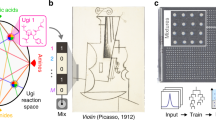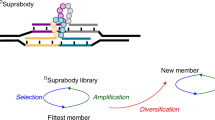Abstract
The isolation of molecules capable of high-affinity and specific binding to biological targets is a central problem in chemistry, biology and pharmaceutical sciences. Here we describe the use of encoded self-assembling chemical (ESAC) libraries for the facile identification of molecules that bind macromolecular targets. ESAC technology uses libraries of organic molecules linked to individual oligonucleotides that mediate the self-assembly of the library and provide a code associated with each organic molecule. After panning ESAC libraries on the biomolecular target of interest, the 'binding code' of the selected compounds can be 'decoded' by a number of experimental techniques (e.g., hybridization on oligonucleotide microarrays). The potential of this technology was demonstrated by the affinity maturation (>40-fold) of binding molecules to human serum albumin and bovine carbonic anhydrase, leading to binders with dissociation constants in the nanomolar range.
This is a preview of subscription content, access via your institution
Access options
Subscribe to this journal
Receive 12 print issues and online access
$209.00 per year
only $17.42 per issue
Buy this article
- Purchase on Springer Link
- Instant access to full article PDF
Prices may be subject to local taxes which are calculated during checkout





Similar content being viewed by others
References
Winter, G., Griffiths, A.D., Hawkins, R.E. & Hoogenboom, H.R. Making antibodies by phage display technology. Annu. Rev. Immunol. 12, 433–455 (1994).
Kohler, G. & Milstein, C. Continuous cultures of fused cells secreting antibody of predefined specificity. Nature 256, 495–497 (1975).
Gold, L. Oligonucleotides as research, diagnostic, and therapeutic agents. J. Biol. Chem. 270, 13581–13584 (1995).
Ramstrom, O. & Lehn, J.M. Drug discovery by dynamic combinatorial libraries. Nat. Rev. Drug Discov. 1, 26–36 (2002).
Schreiber, S.L. Target-oriented and diversity-oriented organic synthesis in drug discovery. Science 287, 1964–1969 (2000).
Otto, S., Furlan, R.L. & Sanders, J.K. Dynamic combinatorial chemistry. Drug Discov. Today 7, 117–125 (2002).
Pellecchia, M., Sem, D.S. & Wuthrich, K. NMR in drug discovery. Nat. Rev. Drug Discov. 1, 211–219 (2002).
Erlanson, D.A. et al. In situ assembly of enzyme inhibitors using extended tethering. Nat. Biotechnol. 21, 308–314 (2003).
Griffiths, A.D. et al. Isolation of high affinity human antibodies directly from large synthetic repertoires. EMBO J. 13, 3245–3260 (1994).
McCafferty, J., Griffiths, A.D., Winter, G. & Chiswell, D.J. Phage antibodies: filamentous phage displaying antibody variable domains. Nature 348, 552–554 (1990).
Shuker, S.B., Hajduk, P.J., Meadows, R.P. & Fesik, S.W. Discovering high-affinity ligands for proteins: SAR by NMR. Science 274, 1531–1534 (1996).
Maly, D.J., Choong, I.C. & Ellman, J.A. Combinatorial target-guided ligand assembly: identification of potent subtype-selective c-Src inhibitors. Proc. Natl. Acad. Sci. USA 97, 2419–2424 (2000).
Hermanson, G.T. Bioconjugate Techniques (Academic Press, San Diego, 1996).
Josephson, S., Lagerholm, E. & Palm, G. Automatic synthesis of oligodeoxynucleotides and mixed oligodeoxynucleotides using the phosphoamidite method. Acta Chem. Scand. B 38, 539–545 (1984).
Velculescu, V.E., Zhang, L., Vogelstein, B. & Kinzler, K.W. Serial analysis of gene expression. Science 270, 484–487 (1995).
Epps, D.E., Raub, T.J. & Kezdy, F.J. A general, wide-range spectrofluorometric method for measuring the site-specific affinities of drugs toward human serum albumin. Anal. Biochem. 227, 342–350 (1995).
Scozzafava, A. et al. Carbonic anhydrase inhibitors. Synthesis of water-soluble, topically effective, intraocular pressure-lowering aromatic/heterocyclic sulfonamides containing cationic or anionic moieties: is the tail more important than the ring? J. Med. Chem. 42, 2641–2650 (1999).
Pocker, Y. & Stone, J.T. The catalytic versatility of erythrocyte carbonic anhydrase. 3. Kinetic studies of the enzyme-catalyzed hydrolysis of p-nitrophenyl acetate. Biochemistry 6, 668–678 (1967).
Carotti, A., Raguseo, C., Campagna, F., Langridge, R. & Klein, T.E. Inhibition of carbonic anhydrase by substituted benzenesulfonamides. A reinvestigation by QSAR and molecular graphics analysis. Quantitative Structure-Activity Relationships 8, 1–10 (1989).
Brenner, S. & Lerner, R.A. Encoded combinatorial chemistry. Proc. Natl. Acad. Sci. USA 89, 5381–5383 (1992).
Doyon, J.B., Snyder, T.M. & Liu, D.R. Highly sensitive in vitro selections for DNA-linked synthetic small molecules with protein binding affinity and specificity. J. Am. Chem. Soc. 125, 12372–12373 (2003).
Hawkins, R.E., Russell, S.J. & Winter, G. Selection of phage antibodies by binding affinity. Mimicking affinity maturation. J. Mol. Biol. 226, 889–896 (1992).
Morgan, G.T. Alfred Werner. J. Chem. Soc. 117, 1639–1648 (1920).
Jencks, W.P. On the attribution and additivity of binding energies. Proc. Natl. Acad. Sci. USA 78, 4046–4050 (1981).
Fersht, A. Enzyme Structure and Mechanism, edn. 2 (Freeman, New York, 1990).
Hajduk, P.J., Meadows, R.P. & Fesik, S.W. Discovering high-affinity ligands for proteins. Science 278, 497–499 (1997).
Rye, H.S. et al. Stable fluorescent complexes of double-stranded DNA with bis-intercalating asymmetric cyanine dyes: properties and applications. Nucleic Acids Res. 20, 2803–2812 (1992).
Neri, D., Momo, M., Prospero, T. & Winter, G. High-affinity antigen binding by chelating recombinant antibodies (CRAbs). J. Mol. Biol. 246, 367–373 (1995).
Fattorusso, R. et al. NMR structure of the human oncofoetal fibronectin ED-B domain, a specific marker for angiogenesis. Structure 7, 381–390 (1999).
Scheuermann, J., Volonterio, A., Zerbe, O., Zanda, M. & Neri, D. Discovery and investigation of lead compounds as binders to the extra-domain B of the angiogenesis marker, fibronectin. Drug Dev. Res. 58, 268–282 (2003).
Strobel, S.A., Doucette-Stamm, L.A., Riba, L., Housman, D.E. & Dervan, P.B. Site-specific cleavage of human chromosome 4 mediated by triple-helix formation. Science 254, 1639–1642 (1991).
Cuenoud, B. & Schepartz, A. Altered specificity of DNA-binding proteins with transition metal dimerization domains. Science 259, 510–513 (1993).
Clackson, T. & Wells, J.A. A hot spot of binding energy in a hormone-receptor interface. Science 267, 383–386 (1995).
Gadek, T.R. et al. Generation of an LFA-1 antagonist by the transfer of the ICAM-1 immunoregulatory epitope to a small molecule. Science 295, 1086–1089 (2002).
Acknowledgements
This work was supported by the ETH Zürich, the Swiss National Science Foundation, the Bundesamt für Bildung und Wissenschaft/EU (STROMA Project) and Philogen. S.M. has been the recipient of a Boehringer-Ingelheim bursary and of an ETH Zürich bursary (special grant: ESACHEL). C.E.D. is a recipient of a bursary from the Roche Research Foundation. We are grateful to J. Sobek and R. Schlapbach for access to instrumentation and help with the microarray technology, and to R. Brunisholz, W. Amrein, O. Scheidegger, O. Greter, P. Hunziker and S. Chesnov for analytical assistance. We thank G. Guarda for help in decoding by sequencing, and R. Buff, O. Schärer and members of the Neri group for helpful discussions.
Author information
Authors and Affiliations
Corresponding author
Ethics declarations
Competing interests
ESACHEL technology is covered by a patent application, which was licensed from ETH Zurich to Philogen S.r.l. under a share of revenues agreement. D.N. owns shares of Philogen and consults for this company. Since August 2003, S.M. and J.S. have received a salary from Philogen. The company also pays for reagents and overhead for ETH Zurich.
Rights and permissions
About this article
Cite this article
Melkko, S., Scheuermann, J., Dumelin, C. et al. Encoded self-assembling chemical libraries. Nat Biotechnol 22, 568–574 (2004). https://doi.org/10.1038/nbt961
Received:
Accepted:
Published:
Issue Date:
DOI: https://doi.org/10.1038/nbt961
This article is cited by
-
Protein-templated ligand discovery via the selection of DNA-encoded dynamic libraries
Nature Chemistry (2024)
-
Trio-pharmacophore DNA-encoded chemical library for simultaneous selection of fragments and linkers
Nature Communications (2023)
-
A DNA-encoded chemical library based on chiral 4-amino-proline enables stereospecific isozyme-selective protein recognition
Nature Chemistry (2023)
-
Small-molecule discovery through DNA-encoded libraries
Nature Reviews Drug Discovery (2023)
-
A mating mechanism to generate diversity for the Darwinian selection of DNA-encoded synthetic molecules
Nature Chemistry (2022)



